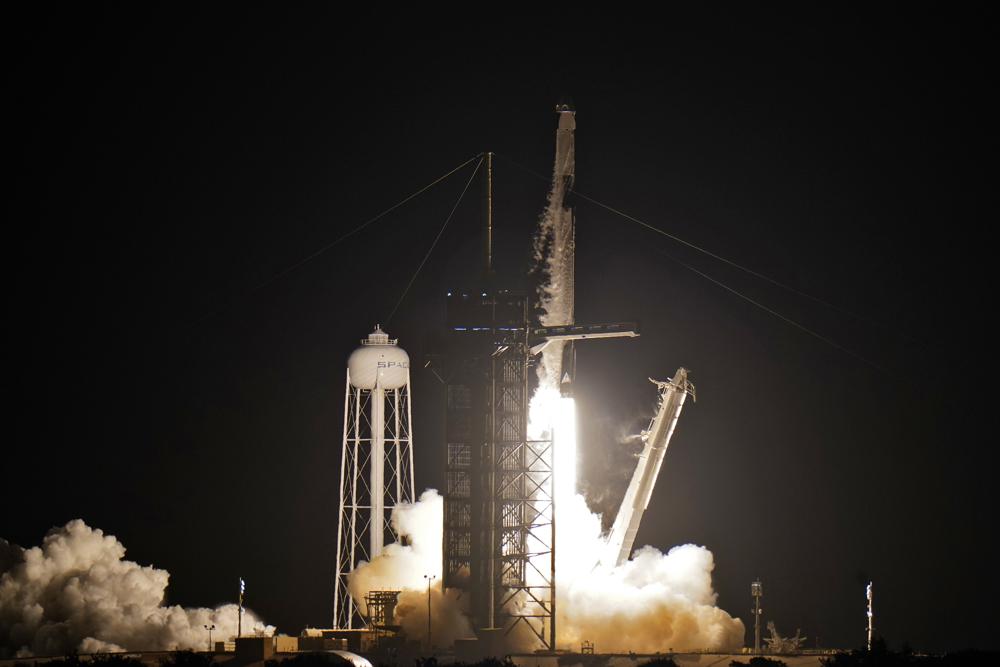Thomas Brodie-Sangster and Talulah Riley marry; Ex-husband Elon Musk reacts
Thomas Brodie-Sangster and Talulah Riley marry in a picturesque Hertfordshire ceremony, beginning a new chapter in their lives.
In the most ambitious leap yet in space tourism, the rocket streaked toward orbit with an all-amateur crew — no professional astronauts for the first time.

A SpaceX Falcon 9, with four private citizens onboard, lifts off from Kennedy Space Center's Launch Pad 39-A Wednesday, Sept. 15, 2021, in Cape Canaveral , Fla. (Photo: AP)
The first private flight of SpaceX blasted off Wednesday night with two contest winners, a health care worker, and their rich sponsor, the most ambitious leap yet in space tourism. It was the first time a rocket streaked toward orbit with an all-amateur crew — no professional astronauts.
The Dragon capsule’s two men and two women are looking to spend three days circling the world from an unusually high orbit — 100 miles (160 kilometers) higher than the International Space Station — before splashing down off the Florida coast this weekend.
Leading the flight is Jared Isaacman, 38, who made his fortune with a payment-processing company he started in his teens.
Advertisement
It’s SpaceX founder Elon Musk’s first entry in the competition for space tourism dollars. Isaacman is the third billionaire to launch this summer, following the brief space-skimming flights by Virgin Galactic’s Richard Branson and Blue Origin’s Jeff Bezos in July.
Joining Isaacman on the trip dubbed Inspiration4 is Hayley Arceneaux, 29, a childhood cancer survivor who works as a physician assistant where she was treated — St. Jude Children’s Research Hospital in Memphis, Tennessee. Isaacman has pledged $100 million out of his own pocket to the hospital and is seeking another $100 million in donations.
Also along for the ride: sweepstakes winners Chris Sembroski, 42, a data engineer in Everett, Washington, and Sian Proctor, 51, a community college educator in Tempe, Arizona. Arceneaux is set to become the youngest American in space and the first person in space with a prosthesis, a titanium rod in her left leg.
The recycled Falcon rocket soared from the same Kennedy Space Center pad used by the company’s three previous astronaut flights for NASA. But this time, the Dragon capsule aimed for an altitude of 357 miles (575 kilometers), just beyond the Hubble Space Telescope.
Their fully automated capsule has already been in orbit: It was used for SpaceX’s second astronaut flight for NASA to the space station. The only significant change is the large domed window at the top in place of the usual space station docking mechanisms.
Though the capsule is automated, the four Dragon riders spent six months training for the flight to cope with any emergency. That training included centrifuge and fighter jet flights, launch and reentry practice in SpaceX’s capsule simulator and a grueling trek up to Washington’s Mount Rainier in the snow.
Four hours before liftoff, the four emerged from SpaceX’s huge rocket hangar four hours before liftoff, waving and blowing kisses to their families and company employees, before they were driven off to get into their sleek white flight suits. Once at the launch pad, they posed for pictures and bumped gloved fists, before taking the elevator up. Proctor danced as she made her way to the hatch.
Advertisement